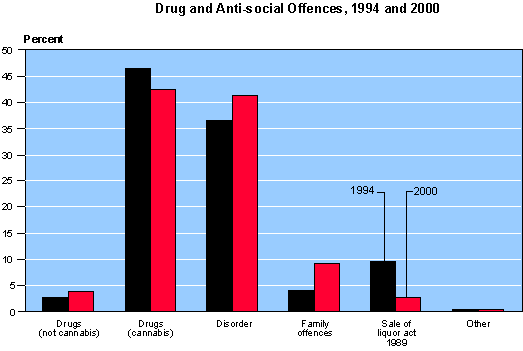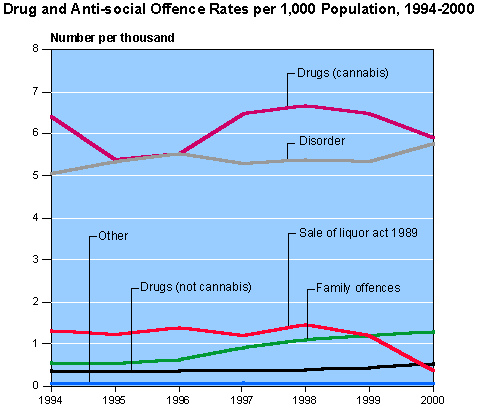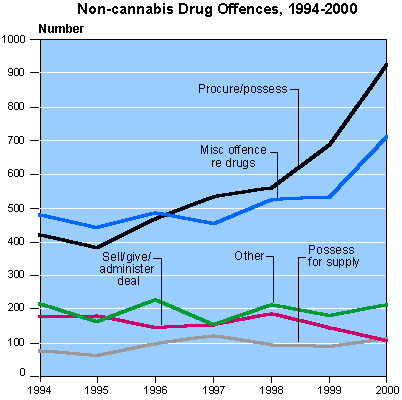| crime.files |
| |
 |
|

| crime.features |
| |
 |
|

| crime.resources |
| |
 |
|

| crime.co.nz |
| |
 |
|


|
 |  |

Drug and anti-social offences
Drug and anti-social offences was the second largest crime category in 2000, comprising 12 percent of all recorded offences. There are seven classes of drug and anti-social offences, the most common being drugs (cannabis only) and disorder, which account for 42 percent and 41 percent of offences in this crime category, respectively. The remaining classes are family offences (9 percent), drugs (not cannabis) (4 percent), sale of liquor (3 percent) and gaming and vagrancy (less than 1 percent each).
Family offences include child abuse, domestic affairs breaches, offences against the Family Proceedings Act, offences against the Guardianship Act, miscellaneous family offences, publishing and document offences, children and young persons offences, tenancy offences, domestic violence offences and miscellaneous breaches.
Gaming and vagrancy offences are combined into the 'other' class in the graphs below.
The resolution rates for all classes of drug and anti-social offences were above 70 percent over the period investigated, and above 80 percent in 2000. The most change occurred in the family offence and sale of liquor offence classes. The resolution rate for family offences improved by 9 percentage points to 81 percent in 2000, while the resolution rate for liquor offences dropped to 85 percent in 2000 after remaining steady at about 95 percent between 1994 and 1999.
Figure 7 shows that in 2000 there were some changes in the distribution of drug and anti-social offences into classes, compared with 1994. There was also some fluctuation in the distribution in the years between. Cannabis drug-related offences fell and disorder offences rose, so there was very little difference between the proportion of drug and anti-social offences in these two classes in 2000, compared with a 9 percentage point difference in 1994. Family offences increased by 5 percentage points between 1994 and 2000, to replace sale of liquor offences as the third most common class of offence in 2000. The latter dropped from nearly 10 percent in 1994 to just 3 percent in 2000. The contribution of drugs (not cannabis) also increased over this period.
Figure 7:

Figure 8 shows that drug offences (cannabis related) had the highest offence rate per 1,000 population of all the drug and anti-social offences between 1994 and 2000. This rate ranged between 5.4 and 6.7 offences per 1,000 population over the period, with a decrease from 6.7 to 5.9 offences per 1,000 population between 1998 and 2000. Non-cannabis drug related offences remained relatively steady over the period. Offences relating to the sale of liquor fluctuated between 1994 and 1999, then showed a significant drop from 1.2 to 0.4 per 1,000 population from 1999 to 2000. This drop was influenced by a December 1999 amendment to the Sale of Liquor Act 1989 so that sale of liquor offences relating to minors became infringements and were no longer recorded as offences.
Figure 8:

Disorder and family related offences both increased over the period investigated. The former rose slightly by 0.6 per 1,000 population between 1994 and 2000 to finish at 5.7, while the latter started at 0.6 per 1,000 population in 1994 and had doubled by 2000 to 1.3 per 1000 population. Changing attitudes of society towards domestic violence may have added to the rise in the number of family offences recorded over the period. Since the late 1980s police have been developing a practice of arresting perpetrators of family violence, thereby leading to an increase in recorded family related offences.
Drug-related offences receive media attention and there has been concern that recreational use of non-cannabis drugs is on the increase. Figure 9 shows that the number of offences relating to the procurement/possession of drugs other than cannabis more than doubled between 1994 and 2000. Miscellaneous offences relating to non-cannabis drugs also show a large increase (50 percent). These miscellaneous offences include permitting use of premises for drug offences and possessing needles for drug use.
However, non-cannabis offences still constitute only a small proportion of all drug offences. In 1994, 6 percent of all drug offences were not cannabis related. This increased to 8 percent in 2000. Also, the non-cannabis drug offence rate remained low at less than 1 per 1,000 population between 1994 and 2000. Any increase in non-cannabis drug offences has the potential to increase other types of offence, for example, increased use of drugs that affect behaviour can lead to an increase in anti-social offences.
Figure 9:

|
 |
|

Drug and anti-social offences was the second largest crime category in 2000, comprising 12 percent of all recorded offences. |
|